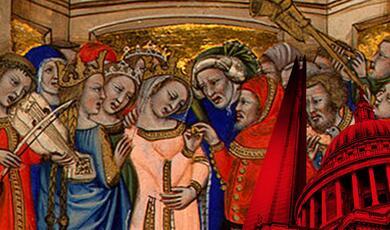Humour and Music
Share
- Details
- Text
- Audio
- Downloads
- Extra Reading
The scherzo (‘joke’) emerged in the vocal music of Monteverdi and became integrated into the string quartets and symphonies of Beethoven. Haydn and Mozart loved to fool around with their audiences and Scott Bradley’s scores for Tom & Jerry are integral parts of the comedic presentation. Clever composers have pranked our emotions for hundreds of years, from slapstick and belly laughs to gallows humour and cruel jibes.
This lecture deconstructs musical laughter of superiority, of recognition, and of the absurd.
Download Text
Humour & Music
Professor Jeremy Summerly
Thursday 31 March 2022
Q. How many Sopranos does it take to change a light bulb?
A. Five. One to climb the step-ladder and change the bulb, and four to shriek ‘It’s too high for her!’.
As with most musical jokes, there is an element of the in-joke. In this case it’s the stereotypical image that Soprano singers are judged by the quality of their high notes (think Mozart’s Queen of the Night aria from The Magic Flute, Gregorio Allegri’s early-17th century setting of the Miserere, or the role of Ariel in the 2002 opera The Tempest by Thomas Adès).
Tenors, on the other hand, are painted as self-centred:
Q. How many Tenors does it take to change a light bulb?
A. Just one to hold the bulb, while the rest of the world turns around him.
In pop bands it’s the drummer who suffers, hence the apocryphal story of John Lennon being asked if Ringo Starr was the best drummer in the world. Lennon’s fictitious response was that Ringo wasn’t even the best drummer in The Beatles. The more sophisticated the musical joke, the more technical its postulate is likely to be. Viola players, for instance, are frequently the butt of jokes within the classical community. Most viola players begin as violinists, and the move from violin to viola is formulaically presented as a demotion to an instrument that plays easier music within the orchestra – a label that is no more appropriate or accurate than a Year 2 teacher being ‘demoted’ to teach in Reception, for instance. The generalisation here (which is not entirely without foundation) is that viola parts contain fewer notes than violin parts, that they are less audible within an orchestral texture, and the notes that they do play don’t have to be executed with the same speed and finesse. So, viola jokes can take the form of the straightforwardly dismissive:
Q. In what way is a viola like a lawsuit?
A. Everyone’s happy when the case is closed.
If you understand that violas (like violins and guitars) are carried around in durable cases for their protection, then you can appreciate the joke, although some would mockingly ask why you’d bother to protect a viola. In a similar vein there is a viola variation on:
Q. How do you tell if a politician is lying?
A. Their lips move.
That is easily modified to become:
Q. How do you tell if a viola player is playing out of tune?
A. Their bow moves.
On a more subtle (though no less cruel) note.
Q. How do you get a viola player to play tremolando?
A. Write a semibreve and mark it ‘solo’.
That may need some explanation. The stereotype here is the fact that viola players are incompetent and consequently nervous about sticking their head above the musical parapet. Tremolando is the technique of so-called ‘scrubbing’ the string with the bow (literally, ‘quivering’). It’s a much-used string-instrument effect, which was developed by the Mannheim Orchestra in the early-18th century and has been used widely ever since. A semibreve is a note of long duration. Ask for that note to be played as a solo, and the hapless viola player is so nervous that s/he can’t control their bow: the result is ‘bow-shake’, or tremolando. The implication is that the only way you can get a viola player to move their bow quickly across the string is to scare them into a reflex action.
Moving even further into the in-joke world:
Q. What’s the longest viola joke?
A. Harold in Italy.
This is my favourite viola joke, presumably because it requires quite a deep knowledge of classical music. It could be told almost as well (and in a less superior manner) this way:
Q. What’s the longest viola joke?
A. William Walton’s Viola Concerto.
That makes the joke more obvious. A viola concerto – and there aren’t many, which rather plays into the hands of anti-viola snobs – is a long piece of music. So a viola concerto is a long viola joke, if you’re of the opinion that viola players shouldn’t be given a solo platform. The punchline ‘Harold in Italy’ is more niche and funnier, but only if you know that Harold in Italy is (in all but name) a viola concerto composed by the early-19th century French composer Hector Berlioz.
As someone who switched from violin to viola many years ago, I find viola jokes funny – I know my limitations. However, as a conductor I’m not sure I approve of the following:
Q. How many conductors does it take to change a light bulb?
A. Nobody knows, because nobody’s watching.
Broadly speaking our response to all of the above jokes could be classified as:
Laughter of Recognition; or
Laughter of Superiority; or
Laughter of the Absurd.
In some cases there is a combination of two of these, perhaps even of all three. In terms of musical composition, there are some obvious jokes. Mozart’s A Musical Joke ends with three unexpectedly dissonant chords. Charles Ives does a similar thing in the rewrite of the end of his 2nd Symphony: the whole orchestra blares out a cacophonous final chord. The result is absurdly funny, as is the point in the last movement of Haydn’s 60th Symphony where the music stops, the violins tune up, and the music continues unabashed. Haydn’s Surprise Symphony (No. 94) is even more famous: it lulls its post-prandial audience to sleep at the start of its second movement before introducing a tumultuous chord out of nowhere to wake the unsuspecting listeners up with a jolt. Haydn even turned an employment grudge into a successful joke. At the end of his Symphony No. 45 (‘Farewell’), the players of the orchestra gradually exit the stage, one by one, to leave just two violins to complete the symphony. Haydn’s musicians had been getting restless and increasingly homesick because they hadn’t seen their families for months. Haydn’s ‘Farewell’ Symphony did the trick, and
Haydn’s employer immediately granted the musicians leave to visit their nearest and dearest. If only all employment disputes could be settled by using humour as a bargaining tool.
And now I’ll get to the crux of humour and music: Mozart’s A Musical Joke of 1787. Is it funny? And if so, in what way? Mozart was 31. Old enough to know better, you might say. But there were extenuating circumstances: Mozart’s father had died on 28 May, just 2½ weeks earlier. So, was this musical joke in some way a tribute to his father? Or was it a backlash composition? The controlling father had died, so now Wolfgang could be his own man? Ein musikalischer Spaß is a Divertimento – a diversion, an amusement. But more than that, it’s actually a series of deliberate jokes. I’ve already mentioned the last three chords of
the last movement, which are absurdly funny. Crash-crash-crash. Musical slapstick. But the whole piece is not so much slapstick, like its ending, but rather a cruel satire of composers less able than Mozart (and late-18th century composers who were less able than Mozart was all living composers apart from Haydn and the teenager Beethoven).
Mozart’s A Musical Joke begins in a dull way, with three chords that are all the same. In spite of its dullness, the first phrase constitutes a reasonable four-bar antecedent, yet the consequent phrase is a bar too short and anyway returns to yet a third statement of the three gauchely repeated chords. At the beginning of the development section – the point at which the expectation is that late-18th century sonata movements should become both impressive and surprising – the formulaic use of the three repeated chords, followed by a deliberately inept modulation (naïve and elliptical rather than momentous) seals the deal: this is clearly not a composition to be taken seriously. Perhaps the best gag of all in this first movement is that there is a repeat mark at its end. Do we want to hear this closing section again? Of course not, but Mozart thinks it’s funny to bombard the listener with it.
Mozart was a stickler for adhering to the rules of harmony and counterpoint. The young English composer Thomas Attwood spent two years, from 1785 to 1787, studying composition with Mozart, and Attwood’s exercises are peppered with Mozart’s corrections and admonitions: ‘you are an ass’; ‘be more attention’ etc. As Mozart’s teaching of Attwood drew to a close, Mozart wrote A Musical Joke. The Minuet is peppered with all manner of clumsy part-writing of the sort that Mozart had witnessed in his pupil’s submissions. Most cruelly of all, Mozart writes a fugue-like section in the last movement, where the fugue is perfunctory and incompetent and is based on a fugue that Attwood himself submitted to Mozart on 13 August 1786. It’s one thing to criticise and correct your pupil’s work; it’s quite another to serve it up for all and sundry to laugh at.
One of the most successful moments in A Musical Joke occurs when the two horn parts are heard playing wrong notes compared to the strings. It’s funny in and of itself, in an absurd way. But these horn parts offer the most involved in-joke in the whole piece. It’s to do with the way that the horn was played in Mozart’s day without the help of modern valves. By placing a hand within the bell of the instrument, the pitch of a note could be changed. Mozart’s joke is that one horn player interprets a passage one way, while the other interprets it another. The result is a harmonic mess. At which point the two hornists realise that something has gone awry and both correct their hand position to what the other was doing. The result is another harmonic mess. This is actually quite a good joke because it works on two levels. The uninitiated hear a very obvious harmonic mess, whereas afficionados of the natural horn are in technical in-joke heaven. However, hornists will laugh less at the point where the horns are given ludicrous lip-trills. Nine bars is a long time for a horn to trill using only the lip, especially as Mozart’s own father had noted the absurdity of horn trills in his musical treatise of 1756 (the year in which Wolfgang was born, as it happens).
The third movement sets the leader of the orchestra up for failure. Mozart is lampooning the small-town musical wannabe. The hapless violinist meanders around his fingerboard without any real point. The violinist himself appears impressed with his improvisatory skills, although he is on his own in this regard. Scales, arpeggios, trills, leaps, and contrasting dynamics are all part of this failed musician’s armoury. And in the cadenza, the poor fellow bites off more than he can chew and ends up getting tonally lost as he climbs into the musical stratosphere, whereupon he tries to salvage the situation by plucking his lowest string for effect. At this point our solo violinist is mercifully rescued by the other players, who hammer the final nail into the musical coffin.
The opening of the final movement of Mozart’s A Musical Joke was for many years used by BBC Television as the signature tune to the Horse of the Year Show. Mozart was lampooning composers who couldn’t write balanced phrases or control their changes of key. A joke to late-18th century audiences, this quirky and unpredictable music was the perfect introduction to a programme which often featured quirky and unpredictable movements of its equine stars. There is also a viola joke in the last movement, where the violas begin late and are heard trying to catch up. Mozart himself was a viola player, so this part of the piece is something of a self-parody. But it’s too little too late. Mozart’s A Musical Joke is at best snide, and cruel at worst. Exaggeration, incongruity, and parody merge together to create a vicious combination of laughter of superiority, recognition, and of the absurd.
There is no Scherzo movement in Mozart’s A Musical Joke; it’s unnecessary because each of the four movements is in itself a scherzo (‘joke’). The scherzo emerged in the vocal music of the Italian innovator Claudio Monteverdi, in two collections of Scherzi musicali (‘Musical jokes’), which were published in 1607 and 1632 respectively. These scherzos are more in the nature of light-hearted music rather than actual jokes. Thereafter, the scherzo began to be used in the Classical era as a substitute for Minuets within string quartets and symphonies – all six of Haydn’s opus 33 quartets of 1781 include a Scherzo, which features as the second movement in Nos 1-4 and the third movement in Nos 5 & 6; indeed the set of six is sometimes known as Gli scherzi.
There are few universals in terms of musical humour: context is everything. Musical jokes are culture-specific, whether they’re the musical backdrop to a French farce – as for instance the stop-start party mania of the final movement of Jacques Ibert’s 1929 Divertissement (‘Diversion’) – or to a cartoon (Scott Bradley’s scores for Tom & Jerry utilise a heavily signposted system of leitmotifs to support the colourful cat-and-mouse drama). And while we’re on the subject of cats:
Q. There are two cats on a steep roof; which cat slides off first?
A. The one with the lowest mew.
If you know that the Greek letter mu (μ) stands for the coefficient of friction, then it’s funny. It’s not just musical jokes whose humour is guardedly in-house.
© Jeremy Summerly, 2022
References and Further Reading
Arthur Koestler The Act of Creation (London: Hutchinson & Co.; 1964)
Gretchen A. Wheelock Haydn’s Ingenious Jesting with Art: Contexts of Musical Wit and Humour (New York: Schirmer Books; 1992)
James J. Fuld The Book of World-Famous Music – Classical, Popular and Folk 5th ed. rev. (New York: Dover Publications; 2000)
Further Listening
Franz Joseph Haydn String Quartet in E flat, op. 33 no. 2 (‘The Joke’)
Wolfgang Amadè Mozart Ein Musikalischer Spaß K522 (‘A Musical Joke’)
Charles Ives Symphony No. 2 (1897-1902 & 1907-09)
References and Further Reading
Arthur Koestler The Act of Creation (London: Hutchinson & Co.; 1964)
Gretchen A. Wheelock Haydn’s Ingenious Jesting with Art: Contexts of Musical Wit and Humour (New York: Schirmer Books; 1992)
James J. Fuld The Book of World-Famous Music – Classical, Popular and Folk 5th ed. rev. (New York: Dover Publications; 2000)
Further Listening
Franz Joseph Haydn String Quartet in E flat, op. 33 no. 2 (‘The Joke’)
Wolfgang Amadè Mozart Ein Musikalischer Spaß K522 (‘A Musical Joke’)
Charles Ives Symphony No. 2 (1897-1902 & 1907-09)
Part of:
This event was on Thu, 31 Mar 2022
Support Gresham
Gresham College has offered an outstanding education to the public free of charge for over 400 years. Today, Gresham College plays an important role in fostering a love of learning and a greater understanding of ourselves and the world around us. Your donation will help to widen our reach and to broaden our audience, allowing more people to benefit from a high-quality education from some of the brightest minds.


 Login
Login







